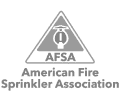Importance of Both Audible and Visible Fire Alarm Systems
Numerous fire codes and regulations at both the federal and local level dictate the features of your fire protection system. While some rules appear trivial, the Houston Fire Marshal can deny occupancy if you fail to meet even the smallest requirement.
The Americans with Disabilities Act (ADA) lays down one such requirement, which is to include both audible and visible fire alarm cues. It seems simple enough, but if you’re not careful, minute regulations within this requirement could result in building occupancy denial. Fortunately, trusting Kauffman Co. for fire alarm design and installation ensures your compliance with this important fire safety system.
Audible Fire Alarms
Loud sirens are imperative because they make individuals with vision impairment aware of the fire danger. A high volume also makes it possible for those who are hard of hearing to perceive the emergency.
The ADA requires audible alarms to either exceed the noise level in the room by 15 A-weighted decibels (dbA) or sound off for at least 60 seconds if they’re only 5dbA louder than the maximum noise level. This ensures the alarm grabs the attention of building occupants no matter how noisy it is.
At the same time, alarm sound levels can’t exceed 120dbA. If the siren is too loud, it can lead to panic and confusion because it’s difficult to yell over.
Another rule dictates that the sound of the alarm must be easily distinguishable from the prevailing sound in the room. Failure to comply with this rule could deny you occupancy.
Visible Fire Alarms
Flashing lights or text banners that visually depict the emergency are important to notify deaf people that they need to evacuate. Regulations state that visible alarms can’t be so intense that they’re unsafe to look at directly or could cause seizures in people with photosensitive epilepsy. To help decrease their perceived intensity, all strobes in a single viewing area must flash in synchrony.
One ADA law requires fire alarm strobe lights to be visible from any location in a room or hallway. So for instance, in a corridor measuring no more than 20 feet wide, visible alarms should be placed no more than 100 feet apart down the length of the hallway and within 15 feet of either end. If you try to cut corners by spacing your visible alarms too far apart, the Fire Marshal could deny you occupancy, forcing you to backtrack and make changes that end up costing more than doing it right the first time around.
Even the color of your visual alarm is important. The ADA states that the flashing light must be clear or nominal white and not exceed a brightness rating of 1,000 candelas (cd). Many flashing strobes are 15 cd, but in brightly lit buildings, the visible alarms may need to be more intense. If you use a colored light or one that is too dim, it may blend in with other lights in the building, causing confusion and failure to serve its intended purpose.
To further ensure visibility, the ADA requires strobe light placement to be between 80 and 96 inches above the highest floor level in the room. If the ceiling height can’t accommodate this, the lights should be installed 6 inches below the ceiling. Placing fire alarm lights too low on the wall could allow obstructions to block the view. Ceiling-mounted strobes are also code-compliant in many instances.
Fire Alarm Design & Installation in Texas
If you need help abiding by the laws and codes established for fire protection systems for your property in the Houston area, please contact Kauffman Co. online or call us today. We offer all the services you need for fire code compliance.















